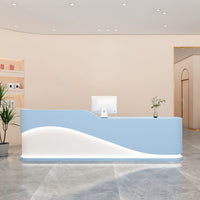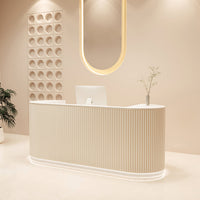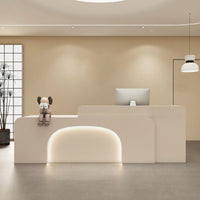Does a Reception Desk Have to Be ADA Compliant?
kaguyasuContent Menu
● Understanding ADA Compliance
● Key Features of ADA-Compliant Reception Desks
● Benefits of ADA Compliance
● Designing an ADA-Compliant Reception Desk
>> Ergonomic Considerations
>> Universal Design Principles
● Implementing ADA Compliance
● Conclusion
● Frequently Asked Questions
● Citations:
Creating an inclusive and accessible environment is crucial for businesses, especially when it comes to reception desks. The Americans with Disabilities Act (ADA) sets standards to ensure that public and commercial spaces are accessible to everyone, including those with disabilities. In this article, we will explore the importance of ADA compliance for reception desks and how it can benefit both businesses and visitors.

Understanding ADA Compliance
ADA compliance is not just a legal requirement; it is a way to demonstrate a commitment to inclusivity and accessibility. The ADA was enacted to provide equal opportunities for individuals with disabilities, ensuring they can access public spaces without barriers. For reception desks, this means designing them in a way that allows wheelchair users to interact comfortably with staff.
Key Features of ADA-Compliant Reception Desks
An ADA-compliant reception desk must have several key features:
- Height: The desk should not exceed 36 inches in height to accommodate wheelchair users. This allows individuals to interact comfortably with staff without having to strain or reach up.
- Length: The desk should be at least 36 inches long to provide ample space for writing and other tasks.
- Knee Clearance: There should be at least 27 inches of knee clearance under the desk to allow wheelchair users to position themselves comfortably.
- Clear Floor Space: A clear path around the desk is essential for easy wheelchair maneuverability.
Benefits of ADA Compliance
Complying with ADA standards offers several benefits:
- Legal Compliance: Ensures businesses avoid legal issues related to accessibility.
- Inclusive Environment: Creates a welcoming space for all visitors, promoting diversity and inclusion.
- Enhanced Customer Experience: Provides equal access to services, improving overall customer satisfaction.
- Positive Business Image: Demonstrates a commitment to accessibility and customer care.
Designing an ADA-Compliant Reception Desk
Designing an ADA-compliant reception desk involves careful planning and attention to detail. Here are some considerations:
Ergonomic Considerations
- Work Surface Height: The transaction counter should be between 28 and 34 inches high to accommodate both seated and standing interactions.
- Material Selection: Choose durable, easy-to-clean materials that withstand daily wear and tear.
- Visual and Hearing Considerations: Incorporate clear signage and assistive technologies to address visual and hearing impairments.
Universal Design Principles
- Adjustable Heights: Incorporate adjustable features to accommodate different user needs.
- Clear Signage: Use high contrast and Braille signage to assist visually impaired individuals.
- Technology Integration: Consider integrating induction loops for hearing aids to enhance communication.
Implementing ADA Compliance
Implementing ADA compliance involves not only designing the physical space but also ensuring ongoing accessibility. This includes:
- Regular Audits: Conduct periodic reviews to ensure compliance with evolving ADA standards.
- Staff Training: Train staff on ADA guidelines to provide excellent service to all visitors.
Conclusion
Creating an ADA-compliant reception desk is essential for businesses aiming to provide an inclusive and accessible environment. By understanding and implementing ADA standards, businesses can ensure that all visitors feel valued and respected. This not only meets legal requirements but also enhances the overall customer experience and promotes a positive business image.

---
Frequently Asked Questions
1. What is the maximum height for an ADA-compliant reception desk?
- The maximum height for an ADA-compliant reception desk should not exceed 36 inches to accommodate wheelchair users.
2. Can existing reception desks be modified to meet ADA standards?
- Yes, existing desks can be modified by adjusting the height and adding lower sections to ensure accessibility for wheelchair users.
3. What is the recommended knee clearance under an ADA-compliant reception desk?
- There should be at least 27 inches of knee clearance under the desk to allow wheelchair users to approach comfortably.
4. Are there any exceptions to ADA height requirements for reception desks?
- Some exceptions may apply based on the type of facility and its use. It is essential to consult the ADA Standards for Accessible Design for specific details.
5. How often should businesses review ADA standards for ongoing compliance?
- Businesses should regularly review updates to ADA standards to ensure ongoing compliance and make necessary adjustments.
Citations:
[1] https://archicfurniture.com/blogs/furniture/ada-reception-desk-height
[2] https://90degreeofficefurniture.com/making-your-modern-reception-area-ada-compliant-things-you-should-know
[3] https://www.michelepelafas.com/product-category/reception/ada-reception-desks/
[4] https://codebuddy.chat/ada-compliant-reception-desk/
[5] https://crossfieldsdesign.com/ada-compliant-front-desk-design/
[6] https://www.reddit.com/r/MadeMeSmile/comments/nbqhmj/inclusion/
[7] https://www.ada.org/resources/practice/practice-management/reception-area
[8] https://www.ada.gov/law-and-regs/design-standards/
[9] https://archive.ada.gov/reachingout/salesservice.html
[10] https://www.access-board.gov/ada/ada-ibc-comparison/chapter-9/
[11] https://www.sohomod.com/ada-compliance.html
[12] https://archive.ada.gov/reachingout/servingcustomers.html
[13] https://rework-furniture.com/blogs/think-outside-the-cubicle/resourcesrequirements-for-an-adacompliant-office-space
[14] https://www.access-board.gov/ada/
---
China, Global, OEM, private label, manufacturers, factory, suppliers, manufacturing company



















